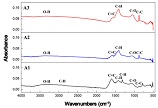Characterization of Carbon Derived from Water Hyacinth as a Renewable Energy Sources
DOI:
https://doi.org/10.19184/cerimre.v1i1.19543Abstract
An alternative renewable energy sources, such as biomass, can be produced using the combustion process inside the furnace. In this work, carbon derived from water hyacinth be produced through carbonization process. The carbonization of water hyacinth was carried out at different temperature i.e. 400°C, 500°C and 600°C and subsequently analyzed with the SEM-EDX to determine the microstructure and atomic percentage of present elements. While the FTIR analysis was conducted to qualitatively verify the surface functional groups of carbon. The results of SEM-EDX analysis showed that the pores began to form at a carbonization temperature of 600°C and carbon content increased with increased temperature of carbonization process. FTIR analysis results showed that the functional groups in the carbon derived from water hyacinth had an absorption pattern with OH, C-H, C-O, and C=C bonds.








